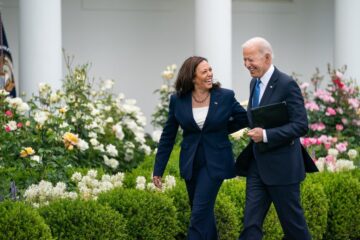The American people have spoken, and democracy has won. After four grueling days of tabulating ballots, Joseph R. Biden Jr. and Kamala Devi Harris have been elected the next President and Vice President of the United States of America. America has chosen science and truth over bigotry and hatred, decency and compassion over intolerance and incompetence. Regardless of your political leanings, this election was an historic one for the country and the American people will rise up and work to this bright future. It means that our nation’s public health experts will be embraced and not silenced, valued and not sidelined.
Welcome back to Week 30 in my weekly reports analyzing the Covid-19 pandemic and its effects on the country and higher education. For those of you reading this on my blog, Off the Silk Road, I have also launched a newsletter, where these reports can be sent directly to your email each week. Click here to subscribe.
Last week, we showed how the American people can use their vote to rescue the country from the pandemic’s darkest days and discussed how college students can stay safe returning home for Thanksgiving. This week, we will look at our hard winter ahead and examine the latest college case counts.
A national look
The U.S. continues to break case records every day, with the nation seeing its first 100,000 case day earlier this week and the COVID Tracking Project recording over 128,000 cases on Saturday, a new record. According to The Washington Post, that number was 134,377 new coronavirus cases. While Americans may have been focused on the election results, coronavirus numbers have continued to rise. A total of 715,000 cases were reported last week. This means that 1 in every 462 people in the U.S. tested positive for Covid-19 just last week.
As President Trump most likely will not focus on the pandemic during his final 73 days in office, more states have begun to impose restrictions on gatherings and require the use of masks in public spaces. Some have imposed curfews, which several experts have questioned the efficacy of since the virus does not take a break at night. At this rate, hospitalizations will rise to previous peaks within a week. As Slovakia tested half of its adult population within a weekend, our testing has mostly remained stagnant. Meanwhile, NPR reported this week that the CDC was aware that the initial test it developed early in the year was flawed, but the agency released it anyway.
Somewhat shadowed by the excitement of the Biden-Harris victory came the stunning (yet not surprising) news from the White House — Chief of Staff Mark Meadows and six administration officials around him have tested positive. This is now the third wave of infections at the White House. (This also comes as former White House strategist Steve Brannon suggested beheading Dr. Anthony Fauci on his online show, “War Room: Pandemic.”) We have already begun tracking those in contact with Meadows and will post updates on our new contact tracing page here.
One of the things that surprised me was how little the pandemic played a role in counties with strong support for President Trump. An NPR analysis found that of the 100 counties with the highest Covid-19 death rates per capita, 68 had a higher proportion of votes cast for Trump in 2020 than they did in 2016. This includes both Republican-leaning counties and counties that supported Joe Biden. “Never underestimate the power of good old-fashioned lying—especially when backed up with the weight of the presidency,” James Palmer writes in Foreign Policy. And as Australia learned to control the pandemic by simply believing in science, the argument can be made that in the U.S., public health lost the election. Results from Tuesday and early Wednesday underscore just how many Americans agree with a president who has called the nation’s top scientists ‘idiots,’ openly mocked mask-wearing, and has insisted states must be liberated’ from lockdowns,” Nicholas Floroko writes in STAT.
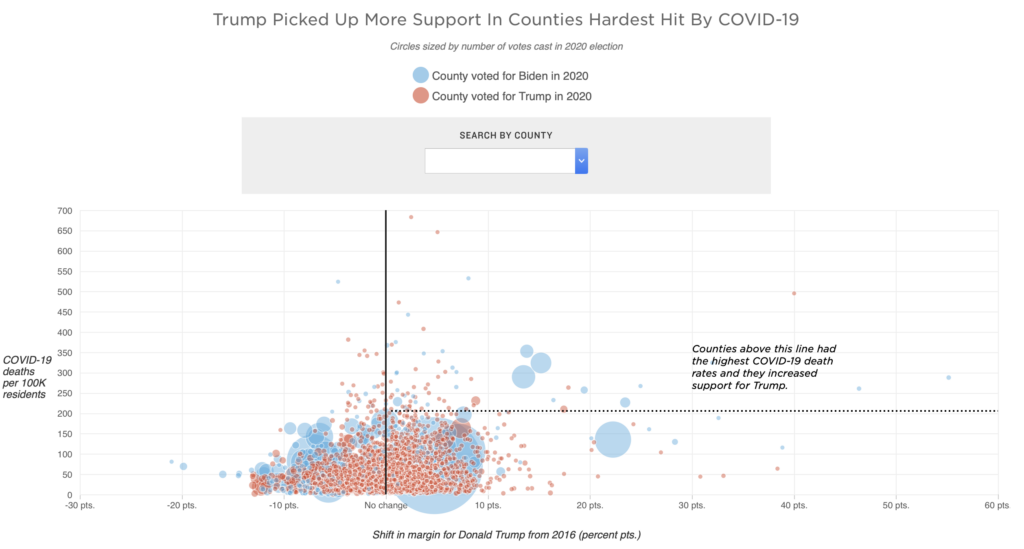
Let’s take a look at some of the latest scientific developments:
- Experts have long advocated for genetic sequencing of the White House outbreak. Through a study of two journalists who tested positive, researchers found that the two genomes were related and the lineage has a common ancestor in April or May.
- A report published in Science Magazine shows that implementing nonpharmaceutical inventions just two weeks earlier than the U.S. did in March could have resulted in one million fewer cases and 60,000 lives saved before May 3.
- In an analysis of approximately 400,000 women aged 15–44 years with symptomatic Covid-19, intensive care unit admission, invasive ventilation, extracorporeal membrane oxygenation, and death were more likely in pregnant women than in nonpregnant women, according to a CDC report.
- Denmark set off alarm bells this week with its announcement that it is culling the nation’s entire mink herd — the largest in the world — to stop spread of the SARS-CoV-2 virus in the prized fur species because of potentially dangerous mutations, however experts say there is no cause for concern.
- An economic analysis finds that the fiscal, macroeconomic, and health benefits of rapid SARS-CoV-2 screening testing programs far exceed their costs.
- A preprint finds that people who had recovered, including those no longer reporting symptoms, exhibited significant cognitive deficits when controlling for age, gender, education level, income, racial-ethnic group and pre-existing medical disorders.
- A new study in Nature found that children infected with the coronavirus produce fewer and weaker antibodies than adults.
- A new study in JAMA found that an estimated 75% of infected contacts need to be quarantined to contain Covid-19, and many contact tracing programs fail to meet this threshold.
- According to a preprint, rapid tests caught 80% of PCR positives but all missed had very low viral loads. This is beneficial as this test caught most people who would be contagious.
- German researchers held a simulated concert to examine the possibility of having large mass gatherings. They found that the expected additional effect of indoor MGEs on burden of infections is low if hygiene concepts are applied and adequate ventilation exists.
- A Duke University analysis found that rich countries have already snapped up billions of doses of potential coronavirus vaccines, potentially leaving poor countries without enough supply for years to come.
- A new CDC report found that state-mandated stay-at-home orders, public mask mandates, case investigations and contact tracing contributed to an 82% reduction in Covid-19 incidence, 88% reduction in hospitalizations, and 100% reduction in mortality in Delaware during late April–June.
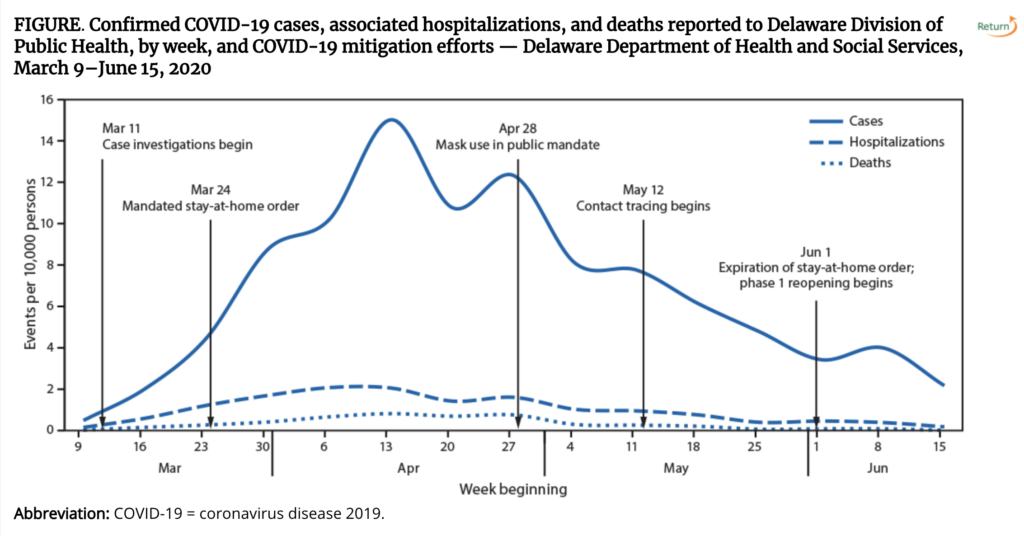
As Trump’s erratic behavior and failure to control the coronavirus doomed his reelection, former Baltimore health commissioner Dr. Leana Wen advocates for immediate action. “America has already lost nine months to inaction,” she writes. “We have no more time to waste. The Biden administration has the mandate of the American people and it must begin its critical work — now.”
Let’s move on to our discussion of higher education.
Higher education
Each Friday, I update the College Watchlist, which is currently tracking 124,100 total cases at 95 colleges. At the top of my list of cases in the last 7 days are:
- University of Illinois – 327
- University of Wisconsin – 241
- Ohio State University – 232
- Brigham Young University – 218
- University of Florida – 203
With rising community transmission nationwide, it is clear we are seeing rising case counts at most of the schools on the list. The total and mean cases in the last 7 days are up.
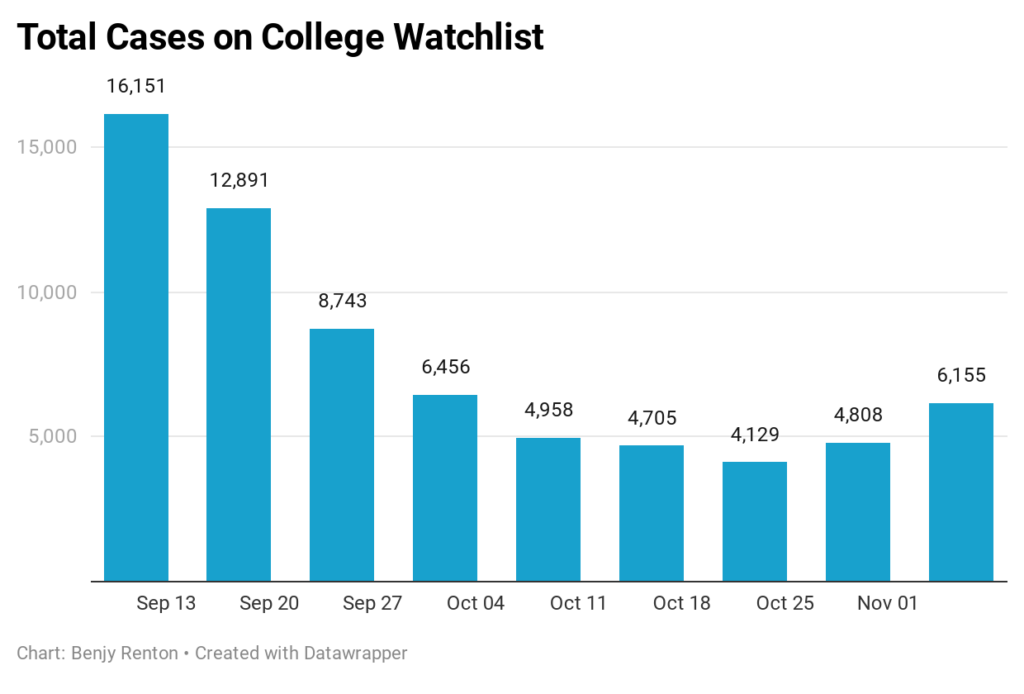
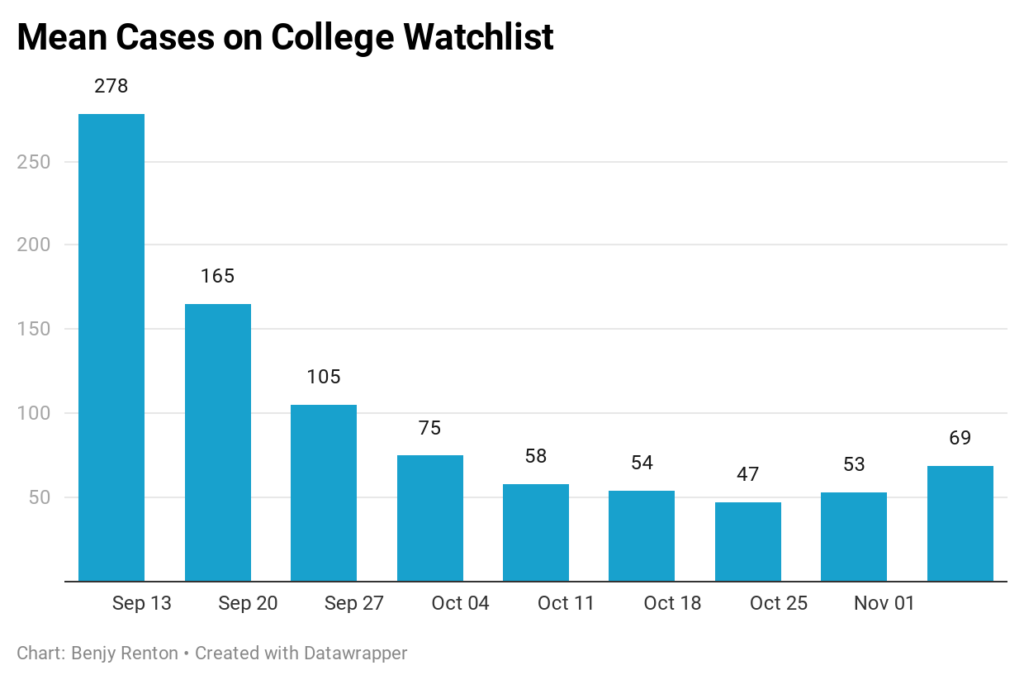
The New York Times’s list of 252,000 Covid-19 cases at colleges accounts for 2.6% of all known cases in the U.S. If U.S. higher education was a country, it would rank 31st in total coronavirus cases, eclipsing the tallies in Canada, China, and Japan.
This week we mourn the loss of Bethany Nesbitt, a 20-year-old student at Grace College who died from Covid-19 complications. Our thoughts and prayers go out to her family, friends and classmates.
Here’s a roundup of this week’s higher ed news:
- How do colleges define “success” in keeping the virus at bay this fall? I talked with Inside Higher Ed’s Elizabeth Redden about how testing has always been key and how we cannot be numb to large case counts.
- Relatively few colleges have released guidance for student travel over Thanksgiving, even though the pandemic is surging nationwide and the holiday is less than four weeks away.
- A new paper uses a decision tree analysis to evaluate a mixture of screening (based on symptoms) and RT-PCR testing. Researchers found that testing all on arrival and 7 days later will catch 86.9% of true positives. To my knowledge, Vermont is the only state that requires two arrival tests for all its college students.
- The University of Michigan has pulled back on more extensive plans for the winter semester given its surge in Covid-19 cases this fall, only allowing certain students to return for on-campus housing.
- We are seeing evidence of a lack of compliance among college students with opt-in testing and contact tracing protocols, this time at the University of Arizona and the University of Kentucky.
- “We’re lonely,” editors at Loyola University in New Orleans write. “We’re depressed. We pay rent to basically live in the cone of uncertainty, wondering if it will be a hurricane or the pandemic that will take us out first. We’re afraid for our futures and for our tomorrows. We don’t feel taken care of by the school that we love.”
- Utah officials plan to require all college students to be tested weekly.
- “The general feeling now is a simple plea: no more Zoom,” editors at American University opine on the university’s spring plans. “Simultaneously, students want to feel connected. The University needs to think more creatively about how students can virtually build connections between each other and the University itself. There are no easy answers, but students cannot continue feeling adrift.”
- Students are skeptical of the University of Pennsylvania’s ability to bring students back to campus in the spring, expecting an inevitable Covid-19 outbreak if the university follows through with its plans for next semester. Building trust with students, especially at institutions who may have rolled back fall plans late this past summer, will be key.
- The Chronicle of Higher Education’s Francie Diep published an analysis of Covid-19 cases in Whitman County, where Washington State University is located. Despite all classes being online, students still returned to the area and cases (and later, deaths) saw a spike.
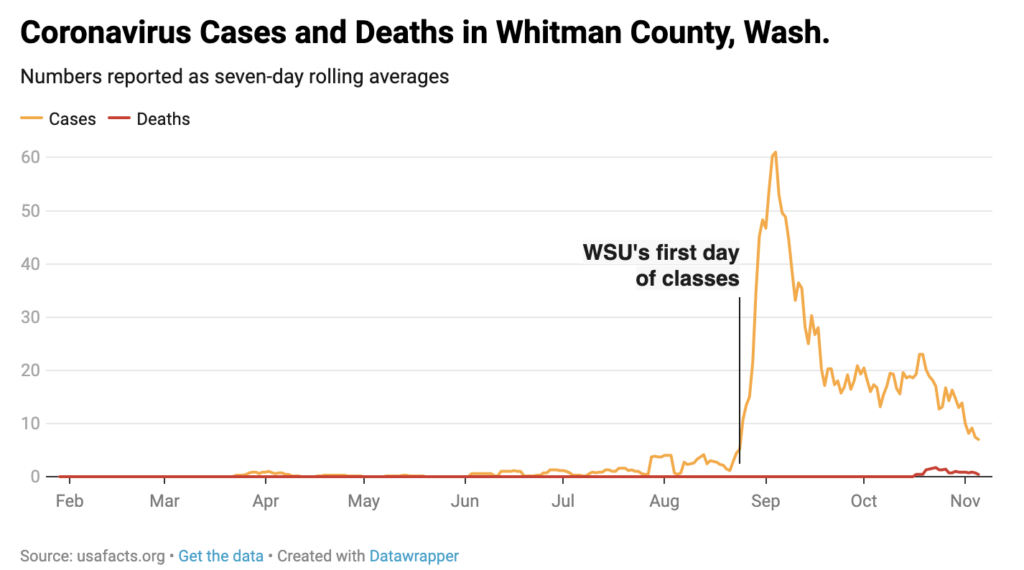
At this rate colleges must do all they can to minimize transmission in preparation for Thanksgiving. It would be incredibly unfortunate for students to be in quarantine and isolation, preventing them from leaving campus on time to return home for the holiday.
The Good Stuff
Let’s roll the clips of the good stuff. In my usual tradition, I feature my favorite stories from the week. Here are my Top 11.
- CNN’s John King received immense praise on the internet for his math skills and tireless math work.
- MSNBC’s Steve Kornacki analyzed election results for nearly 24 straight hours, taking his first break after Election Day on Wednesday afternoon.
- The New York Times’ Amelia Nierenberg discusses the role college journalists have played in covering their campuses this fall, featuring many individuals whose work I have featured in the past.
- Kamala Harris’ ancestral village in India offers prayers for her victory.
- New Yorker Ruth Rosner first voted for a president in 1936, casting her ballot for FDR. At age 104, she now casts another vote.
- Beat reporters share their experiences covering the campaigns, following the candidates for nearly two years.
- Americans sought out junk food and booze as election results trickled in.
- The Philadelphia City Commission set up a camera for the public to watch vote counting live.
- The Washington Post captured the past four days in America, days for the history books.
- The New York Times analyzed polls of more than 17,000 voters to determine which first names are backing President Trump and which are backing Joe Biden.
- It is possible that the Trump reelection campaign ended in a landscaping parking lot.
Conclusion
On January 20, science will return to the White House. We congratulate Joe Biden and Kamala Harris on their victory and wish them the best through the transition. These are historic times for our country and our world.
However, we cannot lose sight of a worsening pandemic spreading all over the U.S. and the approaching Thanksgiving season. The American public should prepare to sacrifice gatherings this year in exchange for keeping schools open. In the final 73 days of a lying and denying, anti-facts and anti-science presidency, it is up to all of us to unite as a country and advance in the fight against the pandemic. But there is faith and hope. President-elect Joe Biden will announce a coronavirus task force tomorrow.
I’d like to thank all the student journalists with whom I have the pleasure of working. In the next weeks and months ahead, they will become vital in chronicling their colleges’ paths forward for the fall and beyond. Support their work by reading it.
My best to all for good health.
Like what you see? Don’t like what you see? Want to see more of something? Want to see less of something? Let me know in the comments. And don’t forget to subscribe to the weekly newsletter!
For more instant updates, follow me on Twitter @bhrenton.

